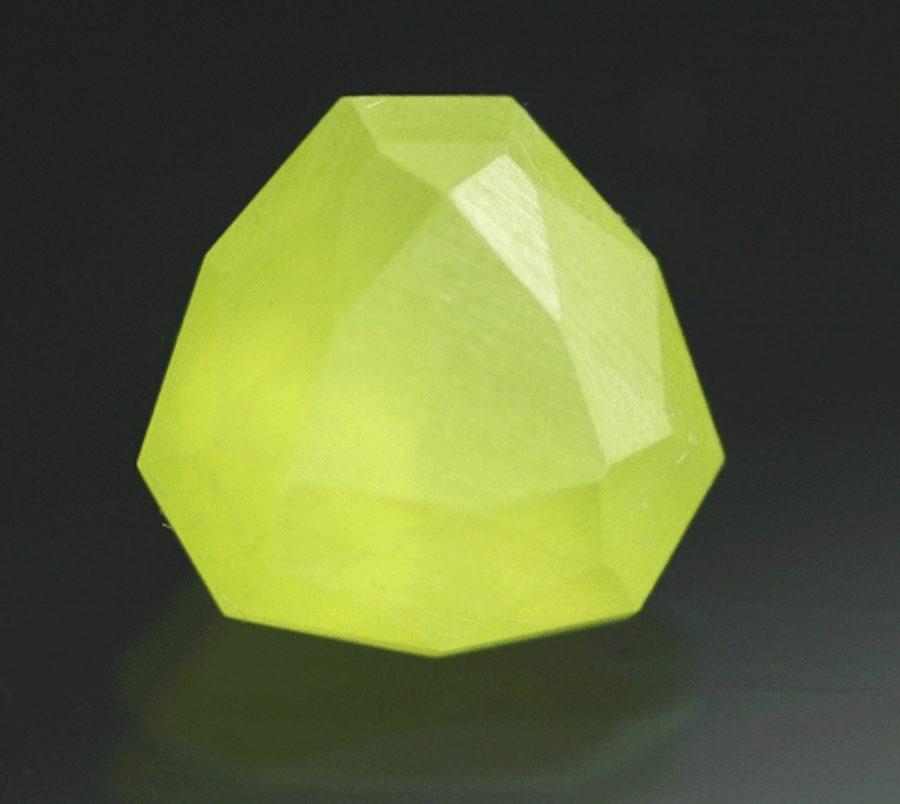Sulfur Value, Price, and Jewelry Information
Although sulfur is very abundant, facetable material is not. Sulfur is also enormously difficult to cut and almost impossible to wear, so faceted pieces have some scarcity value for collectors of unusual gems.
2 Minute Read
Although sulfur is very abundant, facetable material is not. Sulfur is also enormously difficult to cut and almost impossible to wear, so faceted pieces have some scarcity value for collectors of unusual gems.
Start an IGS Membership today
for full access to our price guide (updated monthly).Sulfur (Sulphur) Price
What is Sulfur?
The element sulfur or sulphur (S) occurs as a component of numerous gem materials, including cinnabar and lapis lazuli. However, sulfur itself can also form as a mineral in an orthorhombic crystal. Two sulfur monoclinic polymorphs, sulfur-β and rosickýite, will turn into the orthorhombic variety gradually at room temperature. The orthorhombic sulfur variety, also known as sulfur-α, occurs most commonly in nature.
Does Sulfur Make a Good Jewelry Stone?
To put it mildly, sulfurs lack ideal jewelry stone properties. Sulfur is famous for its many practical applications. However, it's also famously ill-suited for faceting. Sulfurs are so heat sensitive that crystals held in hand may crack due to thermal shock. Since they have both "very brittle" and sectile tenacity, crystals dropped from a height of several inches would most likely chip or crack, and you could cut them with a knife. With a hardness of 1.5 to 2.5, they could also be scratched by a penny. And if you should get sulfur wet, even with perspiration or humidity, you'll experience firsthand the Biblical brimstone's famous odor of rotten eggs.
Furthermore, facetable material, as it were, is uncommon. Nevertheless, some enterprising lapidaries have met the challenge and successfully fashioned tiny gems. Collectors also prize well-formed, natural crystals for display as mineral specimens.
Is There Synthetic Sulfur?
Although natural sulfur is very abundant, scientists have also synthesized it in many forms for many research projects. Sulfur has applications in the production of items as diverse as medicine, gunpowder, fertilizer, wine, and rubber. Understandably, these synthetics don't include facetable crystals for jewelry. The synthetics would have all the shortcomings of natural sulfurs.
However, around 1975, an Italian ornithologist and natural history enthusiast created and sold synthetic crystals designed to appear as natural, top-quality Sicilian sulfurs. As Renato Pagano notes, Dr. Sergio Martinat brazenly admitted he created them in 2000. Evidently, he grew sulphur crystals on authentic matrix from Sicily, artfully arranged to resemble the appearance of highly prized natural Sicilian specimens. In fact, these synthetics proved difficult to distinguish from natural Sicilian sulfurs. (2002)
In 2003, a team of geologists discovered an isotope analysis can determine if sulfurs supposedly from Sicily are likely from there. Kurt Kyser and Renato Pagano discovered that Dr. Martinat used non-Sicilian sulfur from salt domes for recrystallization. (2003)
There are no known gem treatments or enhancements for sulfurs.
Where is Display-Quality Sulfur Found?
Girgenti and Cianciana, Sicily have produced fine, large crystals coveted by collectors. However, these mines are now closed. Bolivia and Russia also produce fine crystals.
Other notable sources of display specimens include the following:
- United States: California; Michigan; Nevada; Texas and Louisiana (salt domes); Wyoming.
- Chile; Mexico; Namibia; Poland; Ukraine.
Stone Sizes
While transparent crystals exist that could yield stones over 50 carats, they make better display specimens than cutting material. Gem cutters may occasionally use broken crystals for faceting small gems.
Caring for Sulfurs
Jewelry use is simply not advisable. When storing or displaying sulfurs, make sure they're dry and not exposed to direct sunlight, since heat and moisture will corrode them over time. Wipe display sulfurs clean with a soft, dry, lint-free cloth only.
For more care recommendations, consult our gemstone jewelry care guide.
Joel E. Arem, Ph.D., FGA
Dr. Joel E. Arem has more than 60 years of experience in the world of gems and minerals. After obtaining his Ph.D. in Mineralogy from Harvard University, he has published numerous books that are still among the most widely used references and guidebooks on crystals, gems and minerals in the world.
Co-founder and President of numerous organizations, Dr. Arem has enjoyed a lifelong career in mineralogy and gemology. He has been a Smithsonian scientist and Curator, a consultant to many well-known companies and institutions, and a prolific author and speaker. Although his main activities have been as a gem cutter and dealer, his focus has always been education. joelarem.com
International Gem Society
Related Articles
Black Diamond Value, Price, and Jewelry Information
Chameleon Diamond Value, Price, and Jewelry Information
Gray Diamond Value, Price, and Jewelry Information
Green Diamond Value, Price, and Jewelry Information
Latest Articles
Milarite Value, Price, and Jewelry Information
Appraising Pearls: How to Grade Pearls
Agate Buying Guide
Carving Techniques for Handling Inclusions in Transparent Gems
Never Stop Learning
When you join the IGS community, you get trusted diamond & gemstone information when you need it.
Get Gemology Insights
Get started with the International Gem Society’s free guide to gemstone identification. Join our weekly newsletter & get a free copy of the Gem ID Checklist!
